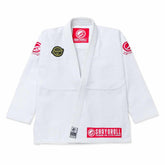How to Start Jiu-Jitsu at 50: Five Essential Tips for Older Beginners
In a world where fitness trends come and go, Brazilian Jiu-Jitsu (BJJ) has proven itself to be more than just a martial art. It is a lifelong journey of physical resilience, mental clarity and personal growth. Many practitioners start BJJ training in their teens or twenties. However, starting Jiu-Jitsu at 50 is not only possible, but it can be one of the most rewarding decisions of your life.
It does not matter whether your goal is to stay fit, learn self-defense or simply find a new community. It is never too late to tie your first belt knot. In this guide, we will cover five essential tips for older beginners. Moreover, we will explore the unique benefits of beginning Brazilian Jiu-Jitsu after 50. With the right mindset and preparation, you can step onto the mats with confidence, no matter your age.
Why Start BJJ at 50?
Before diving into the how, let’s talk about the why. The benefits of starting Brazilian Jiu-Jitsu later in life are extensive:
- Improved physical fitness: BJJ enhances flexibility, balance, joint health and cardiovascular strength.
- Mental stimulation: Every roll is a puzzle, improving problem-solving, memory and decision-making.
- Stress relief: Physical exertion and deep breathing during training help reduce anxiety and depression.
- Social connection: The BJJ community is inclusive and supportive. Thus, providing meaningful relationships at any age.
- Self-defense confidence: Knowing how to protect yourself can be especially empowering later in life.
Still, older beginners often have unique challenges like joint stiffness, slower recovery or past injuries. But with the right approach, these can be navigated successfully.
Tip 1: Start with the Right Mindset
Beginning BJJ at 50 requires a shift in mindset. This is not about being the strongest or fastest on the mat. But it is about longevity, learning and personal progression.
- Leave the ego at the door: You might be training with 20-year-olds who move like panthers. That’s okay. Your only competition is yourself.
- Be patient with progress: Mastery takes time. Do not chase belts or compare your journey with others. Focus on improvement over perfection.
- Enjoy the process: Celebrate small wins—like surviving a round without tapping or learning how to properly escape side control.
This mindset not only protects you from injury but also keeps your training joyful and sustainable.
Tip 2: Choose the Right Academy and Instructor
Not all BJJ academies are created equal—especially for older practitioners. Your experience will largely depend on finding the right environment.
- Look for age-diverse schools: A welcoming academy should have practitioners of all ages and skill levels.
- Prioritize safety: Ask about their focus on technique over intensity. Do they encourage flow rolling? Do they have beginner-friendly classes?
- Speak with the instructor: Share your goals and concerns. A good coach will guide you patiently, understanding your physical limits.
Training at the right place can make the difference between burnout and building a sustainable practice.
Tip 3: Gear Up Properly – Especially Your BJJ Gi
Your BJJ Gi is more than just a uniform. It is part of your training toolset. Choosing the right Gi is critical for comfort, safety and mobility.
- Get a lightweight Gi: Older practitioners often prefer lighter Gis that put less strain on shoulders and joints. Look for breathable fabrics.
- Proper fit is essential: A well-fitted Gi prevents tripping, improves range of motion and reduces the chance of injury.
- Invest in quality gear: You do not need the most expensive Gi, but choose one from a trusted brand. Avoid cheap options that tear or shrink easily.
For those considering No-Gi BJJ, wear proper rash guards and grappling shorts. These reduce mat burns and improve hygiene.
Pro Tip: Always bring a dry Gi or rash guard after training. Staying in wet clothes can increase the risk of illness, especially for older practitioners.
Tip 4: Prioritize Mobility, Recovery, and Nutrition
At 50, your body speaks louder than ever—and listening to it is key. Here is how to keep your training smooth and injury-free:
Mobility and Stretching:
- Warm up before class with dynamic stretches (hip openers, arm swings).
- Cool down after class with static stretches, foam rolling and deep breathing.
- Incorporate yoga or low-impact mobility routines into your weekly schedule.
Recovery:
- Give yourself ample rest between training sessions.
- Use cold therapy, epsom salt baths or massages to aid muscle recovery.
- Invest in sleep—at least 7–8 hours per night.
Nutrition:
- Focus on anti-inflammatory foods like berries, fatty fish, turmeric and leafy greens.
- Stay hydrated and eat enough protein to support muscle repair.
- Avoid excessive sugar and alcohol, which hinder recovery.
Remember: Consistency with recovery is more important than intensity in training.
Tip 5: Train Smarter, Not Harder
You do not have to train five days a week to see results. In fact, many older beginners benefit from training 2–3 times per week with a focus on technique and flow.
- Drill often: Repetitions help you internalize movement without exhausting your joints.
- Roll with partners who respect your pace: Do not be afraid to tap early or ask for lighter rolls.
- Take notes after class: Writing down what you learned boosts retention and helps identify areas for growth.
- Ask questions: Learning never stops in BJJ. Being 50 means you are wise enough to know when to ask and humble enough to learn.
Over time, your game will develop in a way that is tailored to your body, your strengths and your rhythm.
Final Thoughts: Age is Just a Belt Color
Starting Brazilian Jiu-Jitsu at 50 is not a limitation. It is an opportunity. An opportunity to grow physically, sharpen your mind and connect with a tribe that values discipline, respect and lifelong learning.
By focusing on mindset, safety, proper gear like the BJJ Gi, recovery and smart training, you will find that the mats welcome you just as you are. The beauty of BJJ is that it adapts to you—not the other way around.
You may start off feeling like a white belt in every sense of the word. But with time, consistency and heart, you will earn much more than belts. You will earn health, confidence, community—and a new sense of purpose.


















